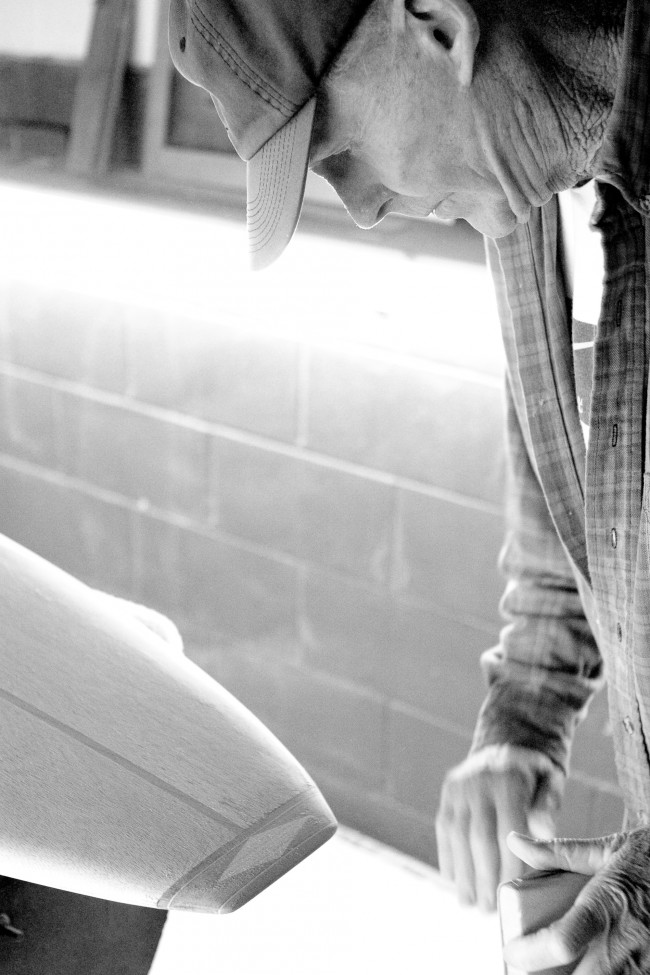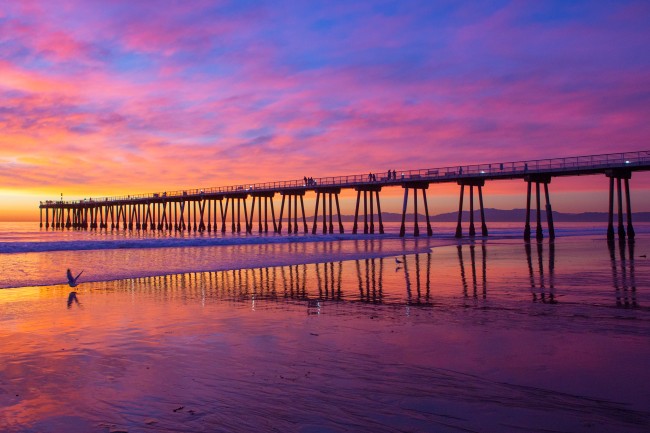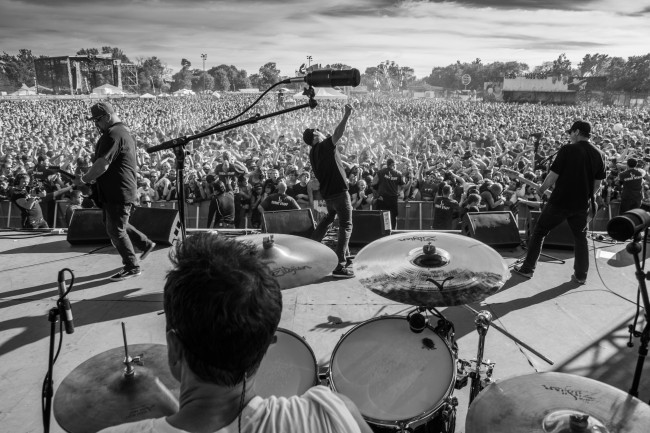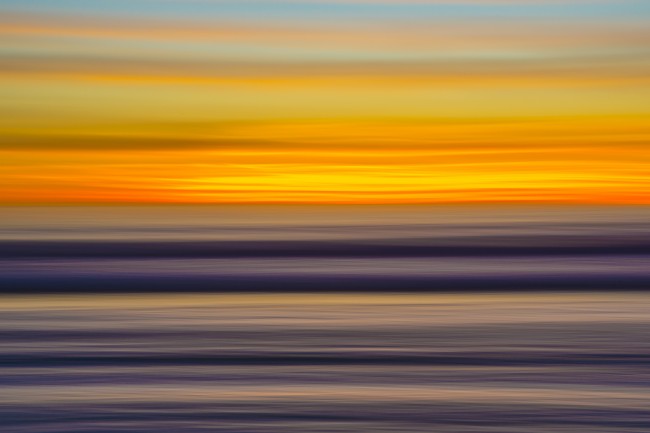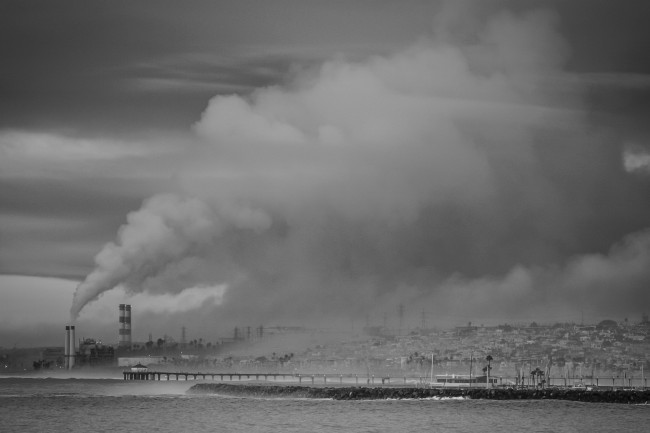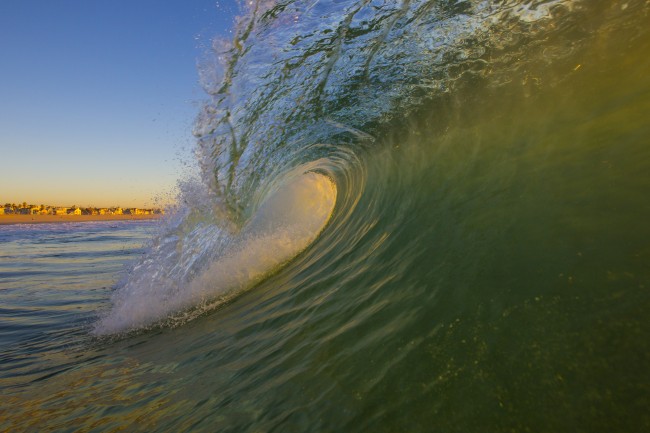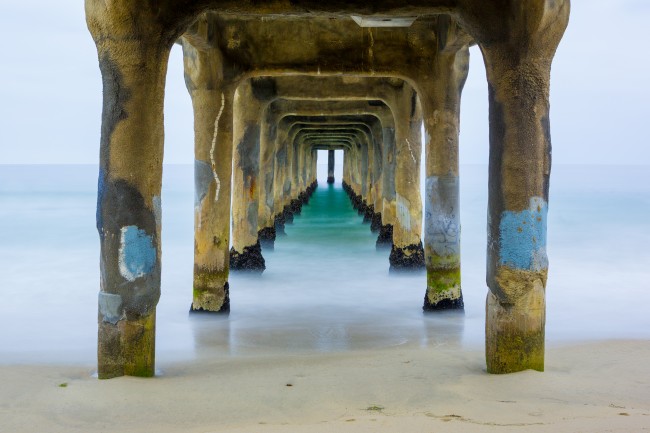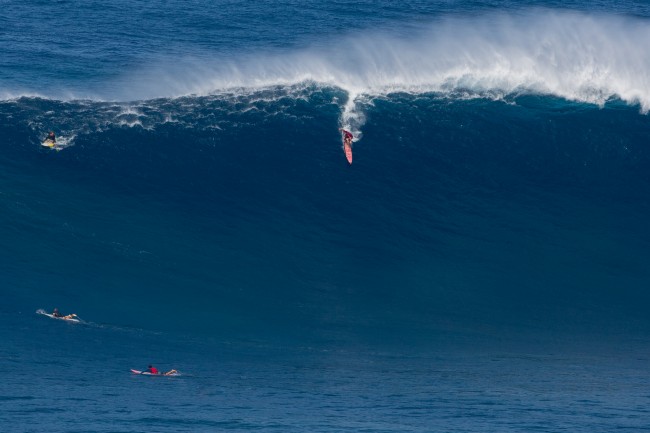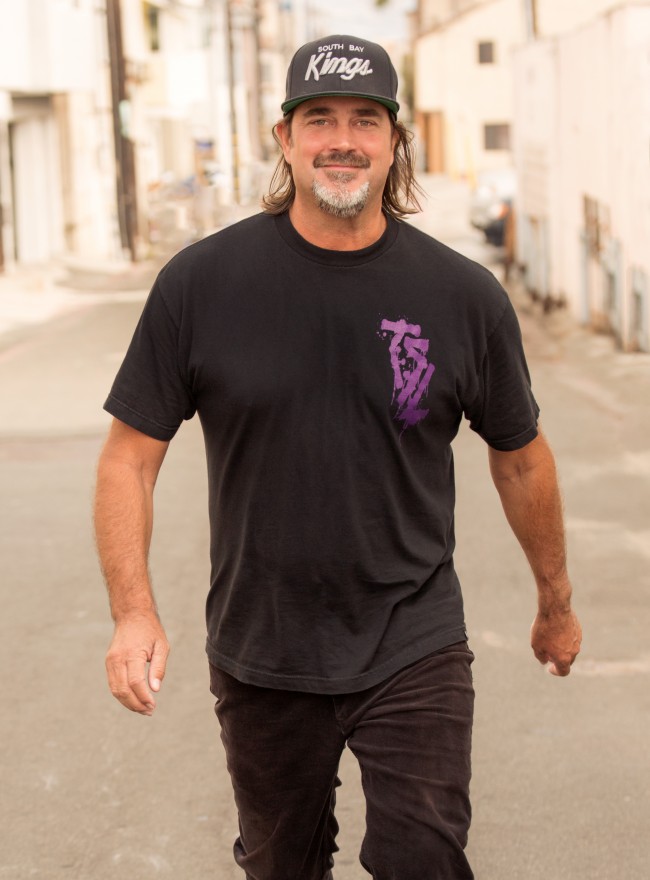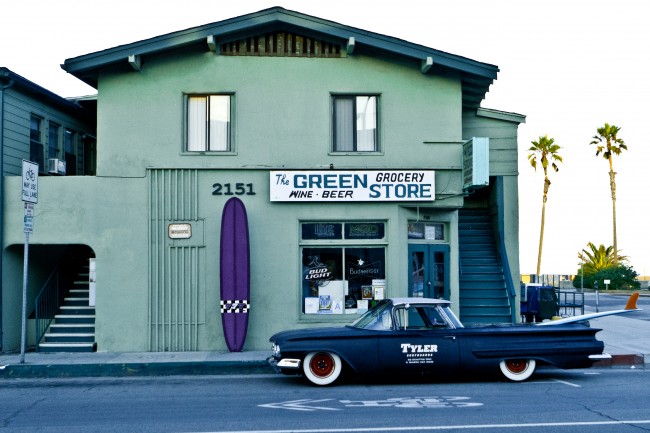Photos by Broza: How Brent Broza became one of the South Bay’s most vital photographers

Brent Broza. Photo by Kelly Fajack Photography
Brent Broza was living a good dream on the day the phone call came. The South Bay native and lifelong surfer had moved to Maui in 2005. He was 36 years old, and he’d built a successful career selling wine. He spent his days driving around tasting and talking about wine, surfing, and immersing himself in the beauty of South Pacific island life.
But on that day in July 2008, life suddenly stood still. Broza stood silently for a moment, phone in hand, looking out across the ocean, taking in what he’d just heard. His father Claude was dying. He had terminal cancer and only a short time to live.
He and Claude had an unusually tight bond. His mother Michelle had died of breast cancer at the age of 50, nearly two decades earlier, when Brent was still at San Diego State. He’d studied communications and while working in restaurants had discovered wine. He possessed a “good palate” and a natural affability that he’d inherited from his big-hearted, convivial father — a big, strapping man who’d operated a home inspection company in the South Bay and was legendary locally for his fun-loving ways. Broza was hired by a division of Kendall Jackson straight out of college as a wine rep. They asked him to return to South Bay to cover nearby territories, and eventually the Beach Cities.
He was only too happy to return to his native stomping grounds, and he and his father — to whom Brent bears a striking resemblance — shared a great decade together, a son getting to know his dad as an adult, and a friend. Brent and Claude cooked together, drank wine together, and at one point, in 2004, took a photo class at Paul’s Photos in Torrance together. Brent found the class too technical for his liking, but afterwards his father gave him his first real camera, a Nikon N80, which he took on a surf trip to the Mentawais later that year.
A few years later, after he’d moved to Hawaii, his father would give him his first digital camera, a 4 megapixel Kodak.
“I’d go around and shoot stuff, just what I thought was cool,” Broza said. “Of course waves. Seascapes, Monkeypod trees, Kiawe trees, just whatever — the ocean, the water, the reefs.”
He gave little thought to it; taking shots was a meditative practice. He tiptoed into the dawning era of social media. “You are invited to join Facebook? What it that?” he remembers thinking. “But yeah, I posted a few shots on Facebook, and MySpace.”
The day he found out his father was dying, Broza quit his job in Hawaii. He packed up, shipped his car, and arrived back in Manhattan Beach two weeks later.
“I had no job, basically nothing,” Broza said. “I came back to spend time with my dad and to care for him as much as I could. He had a Canon Rebel there, a new one — I don’t think he had a chance to use it. He was just kind of tinkering around with it.”
Claude was dying quickly. The heaviness of his father’s impending passing weighed on Brent.
“You appreciate moments. Everything else in life is trivial,” he recalled. “It’s real. You are witnessing death happening. You are witnessing pain and suffering. You are watching your parent die. It’s hard.”
Encounters with death change perception. Time slows down. Moments become precious. Transience is made real. Light upon the earth, upon the water, seems to shimmer. Broza saw the South Bay with different eyes.
“I was pretty much tripping,” he said. “I’d take that camera, during my breaks from watching him, and shoot sunsets, the waves, the piers, Palos Verdes, the Avenues… It was a therapeutic thing for me to kind of release some creativity during that time.”
His father only lasted a month. After he died, Broza decided he’d stay in the South Bay. He started posting his photos more regularly on social media. He was surprised at the positive response he received.
“This is kind of how, with all these nice comments, I started to get a little more confident,” Broza said. “And then shooting just kind of clicked. I was self-taught, and just started to figure things out.”

Brent Broza. Photo by Kelly Fajack Photography
A month after his dad died, a friend, Paul Hatter, helped him obtain photo credentials to a Jack Johnson concert in Santa Barbara. He gave the photos to Johnson. Later, Johnson’s wife reached out to him. The concert had been recorded and was going to be released as an album, “En Concert,” and they wanted to use one of Broza’s photos for the CD booklet.
“I was like, ‘Hell yeah,’” Broza said. “What an opportunity.”
Broza is one of those guys who is almost a social media network unto himself. He knows people, and through those many circles, more opportunities arose, such as an offer to shoot the premiere of Kelly Slater’s surf movie, “The Ultimate Wave Tahiti.” Those photos appeared in Surfer magazine. Broza’s photography career was up and running.
He’d taken another job in corporate wine sales, but his focus was increasingly turning to photography. Soon, he had surfing shots in Surfer. Over the next few years, his shots appeared on Surfline.com, in American Art Collector magazine and on the covers of Easy Reader and Beach. His photography wasn’t any one niche — he photographed artists Shepard Fairey and Craig “Craola” Simkins in their studios, South Bay landscapes, seascapes, musicians, landmarks and personalities.
“I don’t have any one focus,” Broza said. “I just shoot what I think is cool.”
Even in its variety, his work developed a distinct identity. An example is a shot that his lifelong friend, singer Jim Lindberg, used as the cover art for “The Black Pacific,” the band he led in his period away from Pennywise. The photo looks north at perhaps the most commonly photographed subject locally, the Manhattan Beach pier. But it’s a vision of the pier unlike anything that had appeared before. Rather than the sunny, happy beach vibe the pier so often represents, Broza’s shot is in dramatic black and white. Its backdrop are the stacks from the NRG El Segundo power plant, smoke billowing above the entire scene.
Lindberg said that shot, like much of Broza’s work, documents a side of the South Bay only a native would have the eyes to capture.
“An outsider couldn’t really come here and get the essence of the place, or understand the different facets of South Bay life,” he said. “That album cover is a perfect example. It shows the stacks down in El Segundo, and kind of a windy day — it shows the stormy nature of the coast, not the typical sunny beach day. Anyone who grew up in the South Bay knows those kinds of days well. There is a big brightness here, but there are some dark corners, as well.”
Broza also very consciously, and respectfully, comes from a local tradition. He admired the work of pioneering surf photographer LeRoy Grannis all his life, as well as the comprehensive photographic documentation of his friend Robi Hutas, who has spent six decades photographing everything from the disappearing Old Redondo waterfront to every major volleyball tournament in Hermosa and Manhattan Beach.
“I don’t think anyone has documented the South Bay better than Robi Hutas,” Broza said. “And for me, after growing up here — I try to document things that mean something to me, and try to shoot them before they are gone. I mean, I didn’t really start until I was 38, so I’m trying to make up for lost time.”
Daniel Inez, the founder of the local design company M1SK, and a staunch defender of South Bay culture, said that Broza’s photographs speak a uniquely local language.
“This is Brent’s hometown backyard so his point of view is not one of an outsider’s…whether it’s taking photos at a punk show or at the Breakwall, he’s shooting things that he’s had lifelong relationship with,” Inez said. “This makes his work not only genuine, but easy to get behind and support…If there’s a story about the South Bay it makes sense that people from here tell it. I think that’s a big part of why people dig his stuff — he’s one of us, not just some random person with an expensive camera.”
Broza now makes his living primarily as a photographer, running his own wine distribution company as a sideline. On July 16, he will have his first solo exhibition, “Then & Now,” at Hermosa Design.
“Photography has been amazing for me,” he said. “It’s given me a lot of freedom. I can go out and do it whenever I want. If I want to be out at 2 o’clock in the morning, I can do it. It’s created a life for me.”
Though his work is rooted locally, Broza’s reputation has spread globally. Kim Riley, whose Manhattan Beach gallery was the first to show his work, said that Broza has become a brand name, and done so in large part because he has given the world a new perspective on iconic South Bay themes.
“His stuff is just amazing, and just keeps evolving,” Riley said. “The work people buy now is so much different from the standard shot of the Manhattan Beach pier that has been photographed the same way a million times. His art has great value, and we ship it around the world…Brent’s work has a new feel to it.”
Probably the biggest star in the South Bay photo scene today is Bo Bridges. He remembers Broza coming into his first studio, in Hermosa Beach, about six years ago, peppering him with practical questions. He’s watched with admiration as Broza’s work has expanded. He praised how Broza’s work is embedded its own singular style, standing out in an increasingly crowded field.
“The market is so saturated with photographers these days,” Bridges said. “And the technology has made it almost so you can just push a button and get a good shot. But doing that isn’t enough to make a name for yourself. That’s the hard part, and he’s done a great job at it….What he has done is just brilliant.”
Both Bridges and Lindberg said the secret to this success isn’t some mysterious alchemy, or even its local roots — it’s the many thousands of hours Broza has devoted to his craft.

Brent Broza with his father, Claude. Photo courtesy the Broza family
“That really comes from dedication and putting the work in,” Lindberg said. “Pretty much every day he’s up at dawn, taking photos…It’s like in music — very rarely does anyone just take up songwriting and start writing great songs. He had that drive. He put in the time.”
“He was hurting because of the loss of his parents, and like any great artist, he channelled that emotion into something positive….and in so doing captured the beauty of nature around the South Bay and other parts of California. It’s really cool to make that your work of art. And really, he’s just begun.”
Broza is now living another dream, one that his father helped hatch in the final days of his life.
“Basically, it went like this: my dad gave me this gift on his way out,” Broza said. “If that camera hadn’t come into my hands the way it did, I don’t believe I’d be shooting photographs today. It’s weird. But he’d be so stoked.”
Brent Broza’s “Then & Now” runs from July 16 through August 14 at Hermosa Design, 618 Cypress Avenue, Hermosa Beach, with an opening reception July 16 from 7 to 10 p.m.



